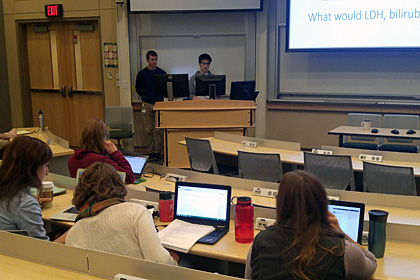The case projected on the screen in the Sullivan Classroom describes a patient – a 55 year-old male with a six-year history of hypertension and a recent acute flare of gout, a type of arthritis – and lists several lab results.

Teaching assistants Joe Miller '17 and Andy Liu '17 stand at the podium in the Sullivan Classroom during a recent Cardiovascular, Respiratory and Renal Systems course review session. (Photo: LCOM Design & Photography)
The case projected on the screen in the Sullivan Classroom describes a patient – a 55 year-old male with a six-year history of hypertension and a recent acute flare of gout, a type of arthritis – and lists several lab results.
“What jumps out at you?” asks fourth-year Larner College of Medicine student Alex Thomas, one of three teaching assistants (TAs) co-leading a Cardiovascular, Respiratory and Renal Systems (CRR) course renal review session on a Thursday afternoon. “Why did he come in?”
“Gout,” says one student in the audience.
“That would be important,” responds Thomas, who then asks attendees to review the lab results and consider the underlying mechanism for gout and what kind of medication the patient might be taking.
“Diuretics,” a student calls out. When Thomas asks what kind, another student offers “spironolactone,” and others respond with “loop diuretic” and “thiazide diuretic.”
“Which of the following is true about the medication likely contributing to this patient’s clinical picture?” says Thomas, prompting more discussion from the group of students readying for an exam the next day.
The Larner College of Medicine’s Teaching and Scholarly Project requirement aims to ensure that senior medical students develop their skills as teachers – a role they will play throughout their career with patients, and immediately following graduation as residents, when they will teach medical students.
For the four weeks of their teaching course, fourth-year students like Thomas have to become an expert in their subject; they have to attend all learning sessions for the course, work with lead faculty members to establish cases for the small-group sessions they facilitate, hold “office hours” for one-on-one tutoring, and produce the material for larger-group review sessions, like the one Thomas and his classmates Andy Liu ’17 and Joe Miller ’17 were leading in preparation for a renal exam.
“They have to be able to explain, in clear and simple terms, what is going on,” says Aaron Hurwitz, M.Ed., a curriculum specialist who teaches in the Teaching/Scholarly Project course. Another main goal, he adds, is the promotion of integration. “We want them to revisit these basic science concepts through the lens of their clinical experience.”
During each group of TAs’ one-month “stint,” he and Eileen CichoskiKelly, Ph.D., director of education instruction and scholarship, hold a series of four workshops, in addition to providing feedback – and guidance – on a regular basis.
First-year medical student Pooja Desai ’20 has been a beneficiary of the TAs’ training.
“I think personally, I have benefited the most from having them assist in anatomy lab,” she says. “The TAs help not only with the physical dissections, but also help explain the broader physiology behind what we’re learning and have helped me make connections between what we’re doing in anatomy lab and what we’re learning in lecture.”
Thomas, the CRR TA, says “With everything I teach – for example, each question – I try to make sure the students learn the one key fact that is most critical about the topic while they are being introduced to the information. Then I provide the rest of the information in a format that can easily be reviewed and integrated into what they already know.”
Each week’s review session, says Hurwitz, “builds on the scaffold of the previous workshops.” He and CichoskiKelly work with the TAs to ensure they are accomplishing the goals they’ve set for themselves, that more discussion is fostered due to their efforts, and ultimately that their students understand the material they are presenting. They encourage the TAs to match review session questions and topics to the level of their learners. Thomas took that advice to heart.
“Having just been in this class two years ago, I remember finding it challenging to balance applying what we were taught to a patient setting, while also trying to use it in preparation for boards,” Thomas says.
Class of 2019 student Sean Closs says his TAs’ perspectives have been valuable.
“They are sympathetic to where we’re coming from as a student; they’ve taken the exams, and are coming from the same mindset,” he says. “In the courses I struggled with more – like anatomy – I leaned heavily on TAs,” Closs admits, adding that he particularly liked the CRR cardiac block TA sessions with clickers and prefers small-group sessions to large-group reviews.
Hurwitz underscores the fact that the TAs function as faculty. “They work with the course director on exam questions and attend all learning sessions for the course,” he says. Having TAs available in that role is particularly important when big changes happen in a course, such as Foundations of Clinical Sciences (FOCUS), which is being offered for the first time this fall. FOCUS course directors Ellen Black, Ph.D., and Stephen Everse, Ph.D., rely on 23 TAs over 18 weeks, the majority of whom teach either anatomy or histology.
For the teaching assistants, a surprise component of that learning is the clinical relevance of the material – an “a-ha” that is consistently experienced by TAs, according to Hurwitz.
“Having completed a year and a half of clinical work, I have much more appreciation for the connections and integration of the material into patient care,” admits Thomas, who says “I have learned many teaching tools and have had time to develop skills that I will continue to use and develop as I progress in my career and take on more prominent teaching roles. This month has been an invaluable experience and learning opportunity.”